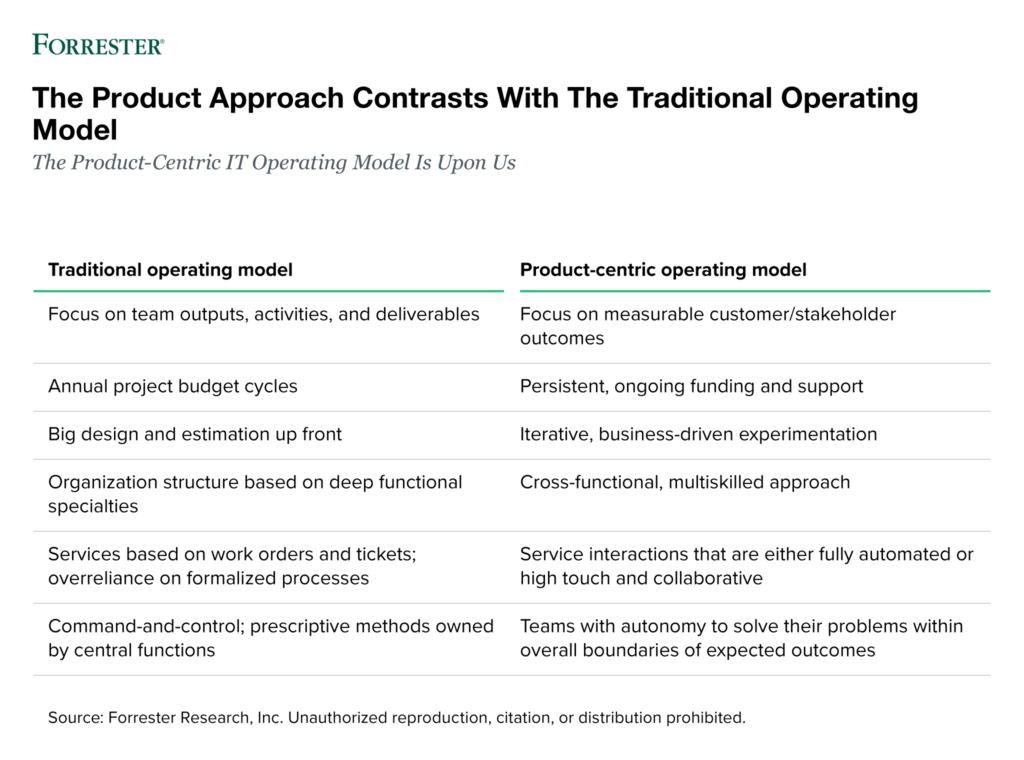Product Centricity Is Coming To Your Organization
I talk to many Forrester customers every week who are transforming: digital, agile, DevOps, or some mix of the three. One common theme is an interest in product team organization.
This has been a hot topic for some time, and interest still seems to be increasing. To explain what a product team is, I use the “EPOCH-A” model: Product teams are empathetic, persistent, outcome-focused, collaborative, heterogeneous, and (relatively) autonomous. In my latest report, “The Product-Centric IT Operating Model Is Upon Us,” I take some time to examine the roots of this new paradigm.
What’s a product? It’s a good, idea, method, information, object, or service that meets a need or satisfies a want. Products can be goods, services, or a combination of both — e.g., your cup of Starbucks in the morning, which is both the service you receive and the item you walk out the door with. Digital services are products. Product management is a practice that market-facing organizations have long used. The popular scrum method increased its exposure, with its required role of a product owner to serve as a conduit for the end customer.
The rise of Silicon Valley unicorns and, more broadly, the digital economy gave increasing prominence to product management practices. New thinkers emerged, such as Marty Cagan, Jeff Gothelf, and Melissa Perri. They found a growing audience for their synthesis of traditional marketing-department-led product management and agile-inspired, rapid, experimental digital innovation. Their ideas have proven influential; there are many “before and after” charts like this in circulation:

These principles are having a major impact on IT operating model structures and are driving a substantial fraction of customer inquiries here. We’re hearing success stories and struggles. While I generally advocate for product team thinking, it does come with some caveats. Not all operational challenges are a fit; large resource pools (business operations, service desks, field services, etc.) are not “teams of product teams.”
In general, product thinking applies when you’re discovering new information — less so when you’re following existing protocols. (Continuous improvement should always apply, so the boundary is rather fuzzy.)
There will also always be a need for core project skills: Any product team may find itself executing a variety of time- and resource-constrained tasks with dependencies and thus may need project management fundamentals.
The biggest challenges in the new model are 1) dependencies and 2) alignment and accountability. Product teams ideally have autonomy, but in large, complex organizations, this is a challenge. As Mike Cottmeyer of LeadingAgile notes, “Where a lot of methodologies fall short is that they don’t deal with cross-team organizational dependencies very well … dependencies don’t self-organize away.”
There is too often no substitute for deep expertise, which is gained through exposure to a problem. But external expertise can lead to blocking the flow of work, and in general, agile thought leaders recommend avoiding it. Automation, T-shaped professionals, and liberal use of stackoverflow.com are often the responses, but all have limitations.
In future work, I’ll be looking more deeply at the trade-offs and challenges posed by product-centric operating models. In the meantime, if you have any thoughts, feel free to drop me a line at cbetz@forrester.com.
Note: I am not a product management analyst per se; I am primarily interested in the impact of product thinking on the IT operating model. Nigel Fenwick covers digital product management specifically, and with the acquisition of SiriusDecisions, Forrester has world-class guidance on market-facing product management, via analysts like Lisa Singer, Sam Somashekar, and Jeff Lash. Be sure to check out my colleagues’ research if you’re actually designing products, figuring out pricing strategies, considering tooling, and so forth.
